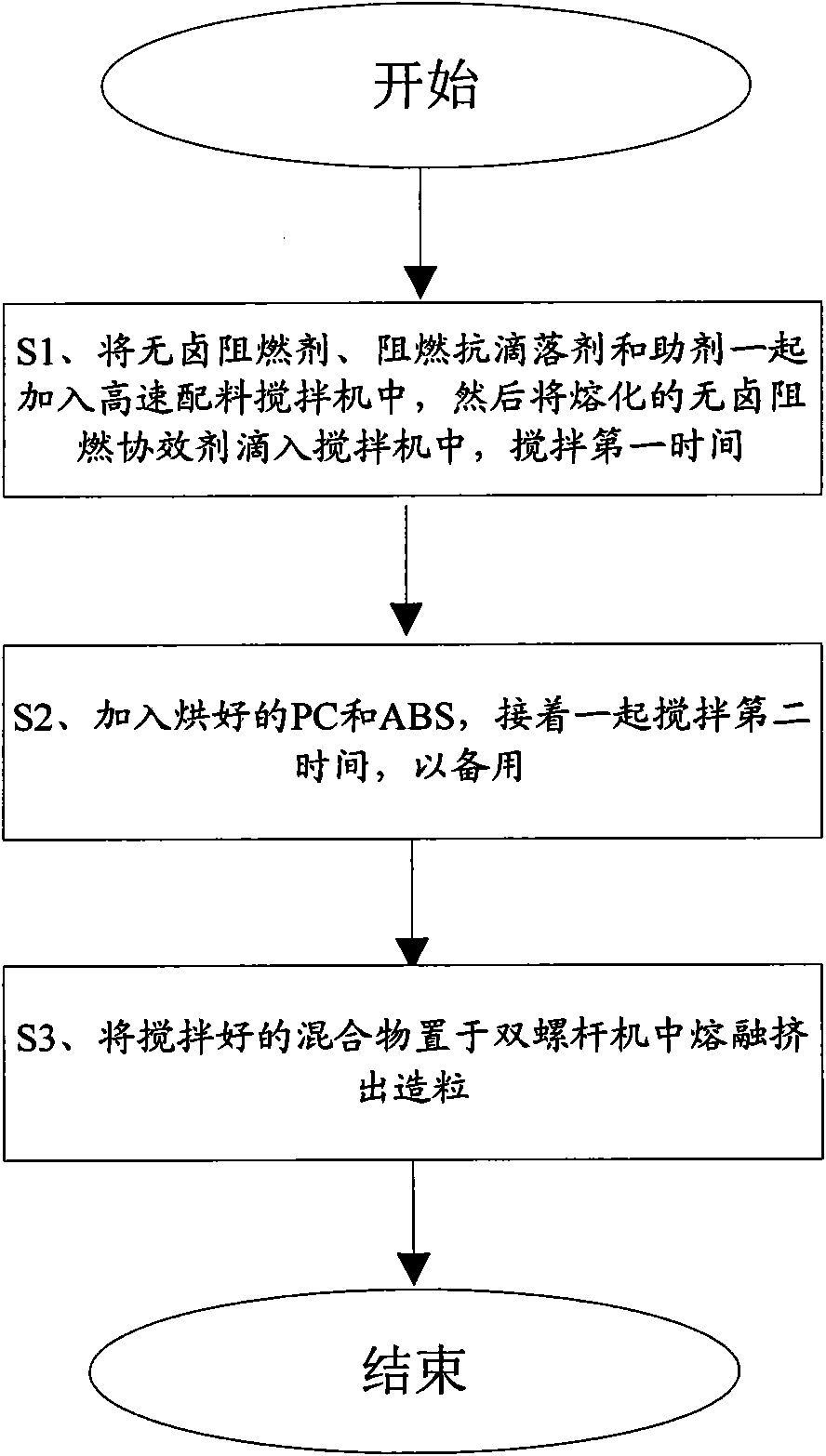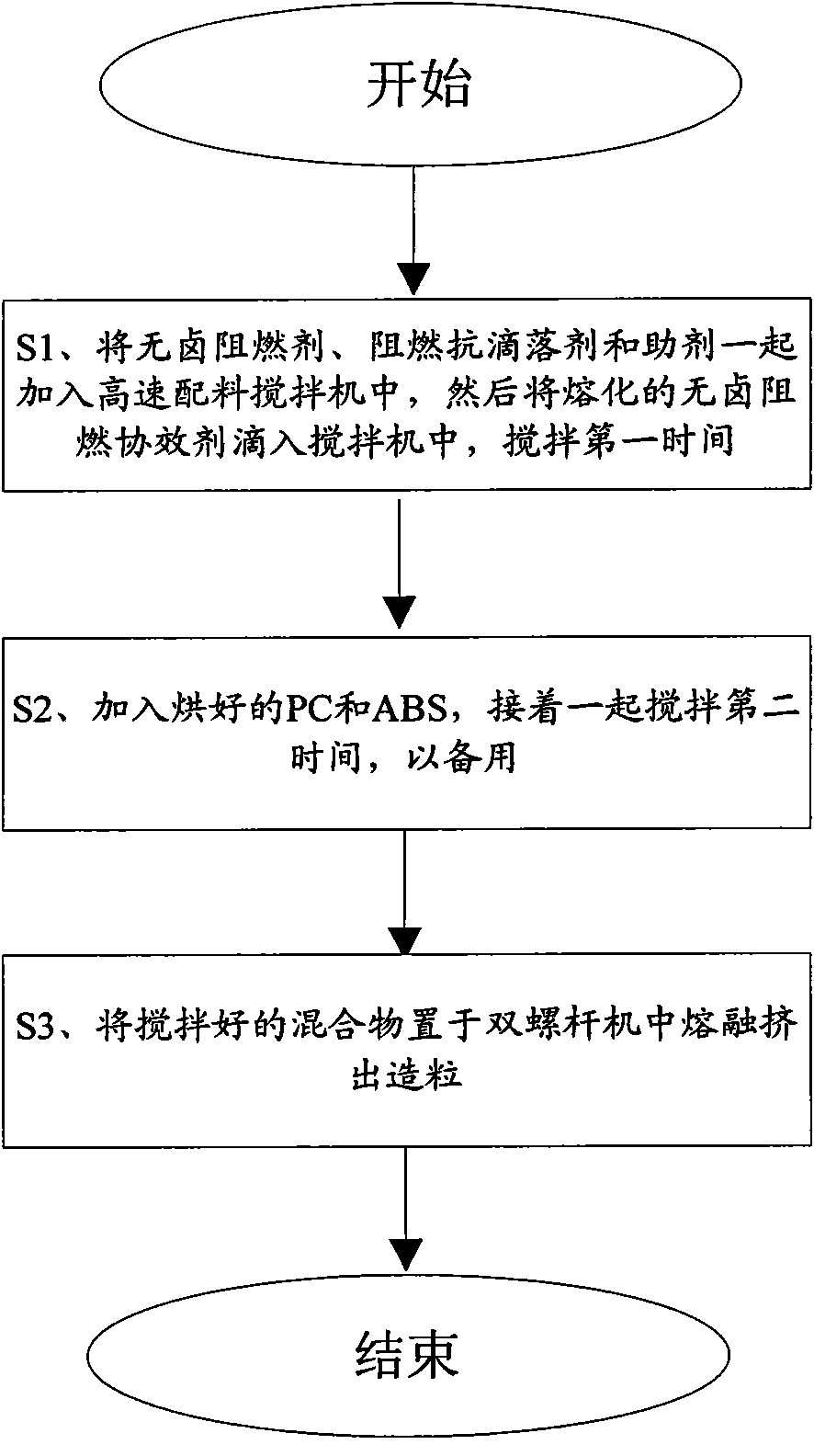PC/ABS alloy and preparation method thereof
A technology of alloy and flame retardant synergist, which is applied in the field of PC/ABS alloy and its preparation, can solve the problems of limited development of halogen-based flame retardants, large amount of smoke, toxic gases, etc., and achieve excellent matt effect, resistance to The effect of good flammability and excellent processing performance
- Summary
- Abstract
- Description
- Claims
- Application Information
AI Technical Summary
Problems solved by technology
Method used
Image
Examples
Embodiment 1
[0054] Add 10% of halogen-free flame retardant, 1% of flame retardant and anti-dripping agent, 5% of toughening agent, 1% of compatibilizer, 1% of low gloss treatment agent, and 1% of antioxidant into the high-speed batch mixer, and then Drop 3% of the melted halogen-free flame retardant synergist into the blender and stir for 5 minutes, and all the above components are in mass percentage. Then add the baked 60% PC and 18% ABS, and then stir together for 5 minutes for later use. Put the stirred mixture in a twin-screw machine to melt, extrude and granulate. The process conditions are as follows: twin-screw first stage temperature 220-230°C, second-stage temperature 230-240°C, third-stage temperature 240-250°C, mold temperature 60 ~100℃, residence time 1~2 minutes, pressure 10~15MPa.
[0055] In this embodiment, the toughening agent is a core-shell type ABS impact modifier with a rubber content of 60-80%. The compatibilizer is ABS grafted malanic anhydride with a graft rate o...
Embodiment 2
[0057] Example 2: Add 12% of halogen-free flame retardant, 0.1% of flame retardant and anti-dripping agent, 7.9% of toughening agent, 1% of compatibilizer, 2% of low gloss treatment agent, and 2% of antioxidant into high-speed batching In the blender, then drop 1% of the melted halogen-free flame retardant synergist into the blender, and stir for 5 minutes, and each of the above components is in mass percentage. Then add baked 62% PC and 12% ABS, then stir together for 7 minutes, and set aside. Put the stirred mixture in a twin-screw machine to melt, extrude and granulate. The process conditions are as follows: twin-screw first stage temperature 220-230°C, second-stage temperature 230-240°C, third-stage temperature 240-250°C, mold temperature 60 ~100℃, residence time 1~2 minutes, pressure 10~15MPa.
[0058] In this embodiment, the toughening agent is a core-shell type ABS impact modifier with a rubber content of 60-80%. The compatibilizer is ABS grafted malanic anhydride wit...
Embodiment 3
[0060] Example 3: Add 7% of halogen-free flame retardant, 0.5% of flame retardant and anti-dripping agent, 3% of toughening agent, 3% of compatibilizer, 3% of low gloss treatment agent, and 1% of antioxidant into high-speed batching In the blender, then drop 3% of the melted halogen-free flame retardant synergist into the blender, and stir for 5 minutes, and each of the above components is in mass percentage. Then add baked 67% PC and 12% ABS, then stir together for 8 minutes, and set aside. Put the stirred mixture in a twin-screw machine to melt, extrude and granulate. The process conditions are as follows: twin-screw first stage temperature 220-230°C, second-stage temperature 230-240°C, third-stage temperature 240-250°C, mold temperature 60 ~100℃, residence time 1~2 minutes, pressure 10~15MPa.
[0061] In this embodiment, the toughening agent is a core-shell type ABS impact modifier with a rubber content of 60-80%. The compatibilizer is ABS grafted malanic anhydride with a...
PUM
 Login to View More
Login to View More Abstract
Description
Claims
Application Information
 Login to View More
Login to View More - R&D
- Intellectual Property
- Life Sciences
- Materials
- Tech Scout
- Unparalleled Data Quality
- Higher Quality Content
- 60% Fewer Hallucinations
Browse by: Latest US Patents, China's latest patents, Technical Efficacy Thesaurus, Application Domain, Technology Topic, Popular Technical Reports.
© 2025 PatSnap. All rights reserved.Legal|Privacy policy|Modern Slavery Act Transparency Statement|Sitemap|About US| Contact US: help@patsnap.com


